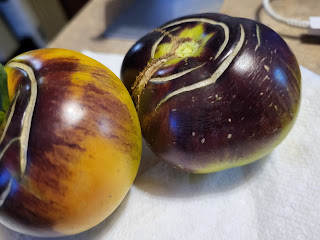I know that saving tomato seeds is a mystery to a lot of people. There are so many different ways to do this. What is the correct way?
I can't say that there's one correct way. I can only share how I was taught to save tomato seeds by Tomato Jim Wyant. It's the fermenting method. I successfully did this last year and grew tomatoes from those that I saved, so I can attest that it does work.
First, you want a specimen that is very ripe. Like if it's past ripe, that's even better! I saved 4 varieties this morning: Prairie Fire, Wolverine, Yamali Yellow and Bug Tussle Buttermilk Wonder. This is how I did it.
First, I determined which varieties that I wanted to save seeds from.
Below is a variety that I obtained from Tomato Jim Wyant called Bug Tussle Buttermilk Wonder. It's my first time to grow a white variety. I was not disappointed. This was one of the best tasting tomatoes that I've ever had. It's definitely a keeper and I'll grow more than one plant of it next year, for sure!
One of the other varieties that I saved seeds from is called Yamali Yellow. It's in the above photo. This particular variety is from my favorite tomato breeder, Tom Wagner. I like his stuff because he's a fellow Washingtonian, like me. I could not find this variety for sale from any seed vendor in the United States. A very kind friend, who lives outside of the United States, sent me the seeds. I'm forever in her debt for getting me the Yamali collection.
Next, I wrote what the variety is on a piece of paper towel.
Then, you simply cut the tomato in half and scoop the seeds out into a jar or a glass. I use Solo cups. I use the end of a metal measuring spoon to help me get all the seeds out.
The seeds and part of the pulp go into the Solo cup.
Then I top it with a couple of inches of water. If you are using city water, I'd recommend using bottled spring water. I am on a well and our water tests out fantastic, so I just use that.
Top the glass/cup with the paper towel. You can also use a coffee filter. They work really well, too. Secure with a rubber band. Put in a dark, not-to-warm spot for a few days and then start checking them. Once you see mold on the top of the water, you should be good to go.
The mold indicates that the gel that encases the tomato seed has fermented off and your seeds are ready to be rinsed and dried. I'll post another blog once I'm ready to do the final cleaning of the seeds, so stay tuned for that.
Once all is said and done, the birds get a nice tomato snack! They will love that!









